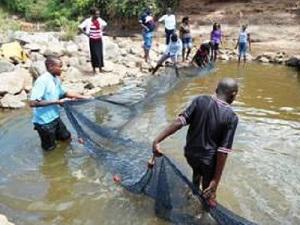Romulus Abila
The aim of the project is to identify the biodiversity of ‘dryland wetland’ in arid South Eastern Kenya and assess the role of the wetlands as a source of alternative livelihood in poverty alleviation.

Ichthylogical survey of the Mwitasyano river.
The damming of the Mikuyuni and the Mwitasyano, two seasonal rivers found within the arid south eastern Kenya, have led to creation of permanent wetlands in this highly water stressed environment. The recently established South Eastern University College is found within the catchment of these two rivers. These ‘ dryland wetlands ‘are not only a source of irrigation and domestic water, but also habitats to a wide array of aquatic biota. However, there is inadequate scientific information on the ecology and local knowledge and community utilization of these wetlands. The increasing population as well as weather variability within the catchment may have several impacts on the biodiversity and water resources from the river basins. Therefore, it is crucial to analyse and document the biodiversity for monitoring and evaluation of the effects of the increased utilization of these resources.

The goal of this research is to assess the ecological and socio-economic significance of these wetlands by pursuing the following objectives:
i) Determining the limnological status and identifying the existing flora and fauna within the wetlands, their density and diversity and any threats facing them,
ii) Assessing the utilization of the wetlands by the community and their impacts on the ecosystem and identifying alternative sustainable wetlands uses,
iii) Creating awareness among local community including school children on the importance of wetlands,
iv) Building the capacity at the local community level and disseminate information on the role of ‘dryland wetlands’ as a source of alternative livelihood in poverty alleviation.